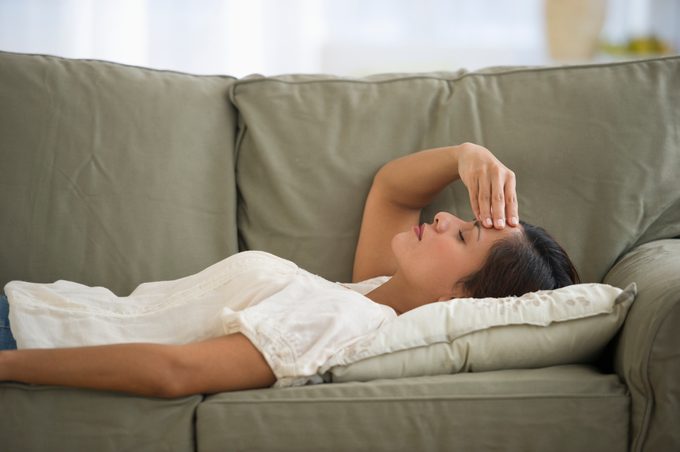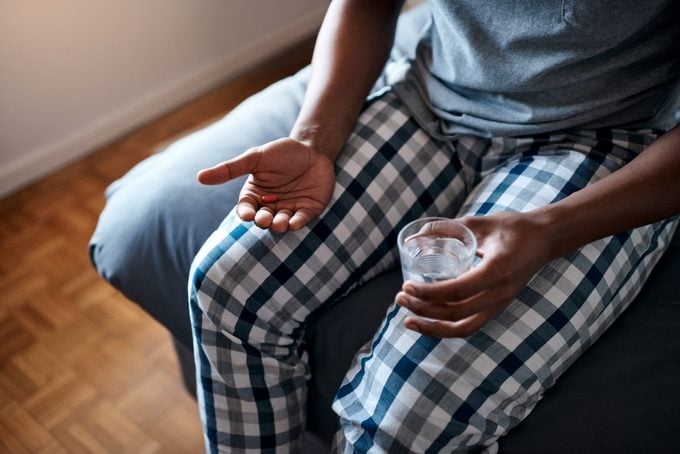What’s the Difference Between a Migraine and a Headache?
Updated: Mar. 11, 2022
Is that pounding in your head a migraine or a headache? Headache specialists reveal how to tell the difference—and the causes, symptoms, and treatments.
You have probably been sidelined by a headache at one time or another. The pain can be intense, often resulting in missed days at work or school. Understanding the type of headache that you are experiencing is the first step toward relieving your pain and preventing future attacks.
What is a headache?
Headaches are typically characterized by the level of pain and how often they occur. For example, the National Institute for Neurological Disorders and Stroke says some people will experience a headache once or twice a year, but there are others that will have headaches for over 15 days a month. When it comes to pain, it can range from mild to severe, and come with a multitude of symptoms, like nausea or sensitivity to light. This is all contingent on the type of headache you develop.
Types of headaches
There are more than 150 types of primary and secondary headache disorders, according to the International Classification of Headache Disorders, but some primary headaches—namely migraine, tension, sinus, and cluster—are much more common than the rest, says Brian M. Grosberg, MD, director of the Hartford Healthcare Headache Center at the Ayer Neuroscience Institute and a professor of neurology at the University of Connecticut School of Medicine in Hartford.
Deducing your head pain begins by ruling out secondary causes, he says. That means looking for other diseases or conditions that may have caused your head pain. “We look for red flags or worrisome features that may be indicative of a secondary headache disorder, such as fever, unexplained weight loss, rash, chills, seizures, or headaches that are getting worse in frequency and intensity,” Dr. Grosberg explains. For example, so-called “thunderclap headaches” come on fast and furious, he explains. “The pain peaks in intensity within seconds to a minute and that may be indicative of something more concerning.” (Here are 15 signs your headache could be something more serious.)

Tension headaches
These are the most common types of headaches, says Dr. Grosberg. Symptoms include mild-to-moderate pain on both sides of your head or face. “It feels like a band or vice around your head,” he says. Unlike with migraine pain, there is no pulsation or throbbing with tension headaches. “You may experience sensitivity to light or sound, but not both with tension headaches.”
Migraine and tension headaches may share some triggers—namely stress, skipping meals, and changes in sleep patterns, says Noah Rosen, MD, director of Northwell Health’s Headache Center in Great Neck, New York. But “physical activity can exacerbate a migraine—not a tension headache.” Most individuals with tension headaches can go on with their day-to-day activities with their head pain. Often times, tension headaches can be treated at home with over-the-counter headache remedies and behavioral changes, he notes.
Sinus headaches
Just what they sound like, these come on when you’re nasal passages are stuffed up due to a cold or allergies. Along with congestion, they can include symptoms like cough, fever, and facial pressure—migraines are often mistaken for sinus headaches, reports the American Migraine Foundation. The difference is that you’re likely to get discharge from your nose with a sinus headache.
Cluster headaches
Cluster headaches, as their name suggests, occur in groups. “You may have periods of weeks to months or longer where you have daily to near-daily attacks,” Dr. Grosberg explains. “Cluster headaches can occur one to eight times a day, with an average of two to three times a day, and the pain on a scale of 1-10 is 100,” he says.
It’s been described as a stabbing pain behind one eye or at the temple near the forehead. “The pain peaks within 5-15 minutes and is almost strictly one-sided,” he says. Cluster headaches can last 15 minutes to three hours.
Unfortunately, many people with cluster headaches often go misdiagnosed and are inadequately treated as a result, Dr. Grosberg says. “Pain on one side of the head often travels with tearing or redness of the eye on the same side as the pain, congestion in the nostril on that side or dropping of the eyelid on that side, and can be mistaken for allergies or a sinus infection.”
Cluster headaches tend to strike at the same time of day and same time of year in people who get them. These patterns are not seen with other types of headaches, Dr. Grosberg says. People with migraines tend to get relief lying in a cold, dark room, but cluster headaches can cause restlessness and agitation. “You may pace back and forth,” he says.
Cluster headaches are more common in men than women, says Cynthia E. Armand, MD, a migraine specialist and assistant professor at The Saul R. Korey Department of Neurology at Montefiore Medical Center in the Bronx, New York. “Cluster attacks are pretty severe, so the cornerstone of cluster treatment is a medication that needs to be given fairly quickly,” she says.
A migraine is more than just a headache
As many as one billion people experience blinding migraine headaches, states the American Migraine Foundation. Migraines disproportionately strike women. Exactly why this occurs is not fully understood, says Dr. Armand. “Prior to puberty, migraine tends to happen more often in males than females, and after puberty, that changes,” she says. Some women do experience migraine headaches during menstruation, so hormonal changes may play a role in this gender disparity, she continues. “Women may also be more likely to seek care and talk about head pain than men.”
Migraine is a neurological disease that involves a constellation of symptoms, including mild-to-severe head pain that pulsates and throbs, Dr. Grosberg says. “These headaches tend to build up over time and are associated with light and sound sensitivity as well as nausea and vomiting.” Migraine headaches can last up to 72 hours and there are different types of migraines. They’re linked to an increased risk for stroke, depression, and other diseases, according to the American Migraine Foundation. (Here are some other side effects of migraine.)

Aura and visual disturbances with migraines
Some migraines are preceded by an aura or visual disturbances such as flashing lights, zigzag lines, or a temporary loss of vision, but the vast majority of people have migraines without aura, Dr. Grosberg says. Stroke risk tends to be higher in people whose migraines are heralded by aura. If you’re at risk for a stroke, the acronym F.A.S.T. could save your life.
Stress, lack of sleep, skipping meals, hormonal fluctuations, weather changes, dehydration, and certain foods such as chocolate, dairy products, artificial sweeteners, caffeine, and cured meats can bring on a migraine in someone who is susceptible, notes the American Migraine Foundation. Migraine treatments, including migraine prevention drugs, are available. (More on this later.)
Figuring out your headache type
So, how can you tell if it’s a migraine, tension, or cluster headache?
It’s not always easy to tell as there is overlap in symptoms and you can experience different types of headaches, Dr. Armand says. Her advice? Keep a headache diary. “This is a powerful tool,” she says. “It allows you to get ahead of your headaches.” She suggests starting by simply drawing an X on the calendar for every day that you experience a headache. “Once you get the hang of that, start detailing the characteristics of your headache. What does it feel like? How long does it last? What medications did you take? Did they help?” Dr. Armand says. “After diving into the characteristics, dive into your triggers.” This information can help you and your doctor figure out what type of headaches you are experiencing and what triggers them so you can learn to stop your headaches before they start.
(Don’t know what it could be? Here are 15 migraine triggers you should know about.)
Headache and migraine treatments
The good news is that many treatments are available to help stop your headaches and migraines once and for all. Migraine treatments, in particular, fall into two main categories: Abortive or those that stop headaches once they have started and preventive. The other are those that are taken daily to keep migraines away, Dr. Armand says.
Over-the-counter headache and migraine remedies
Over-the-counter pain (OTC) killers including those that contain ibuprofen, acetaminophen, and aspirin work best when taken before your migraine pain gets really bad, the National Headache Foundation notes. Tension headaches often respond to these as well, explains Dr. Armand. You could also experiment with natural headache remedies, he says.

Prescription migraine medications
There are some prescription medications that are classified as “abortive” because they head off the pain before it intensifies. They’re available in many forms including nasal sprays, rapidly-dissolving tablets, and those that can be self-injected. “If you get a migraine once a month or once every six months, an abortive strategy may work. But if your migraines start to occur more frequently and you are moving into a chronic phase, I would consider preventive migraine treatments.”
The newest class of prescription meds is calcitonin gene-related peptide (CGRP) monoclonal antibodies. This is the first class of drugs designed specifically for migraine prevention, Dr. Grosberg says. There are currently four CGRP drugs approved to prevent migraines.” Three are given as monthly injections and one is given quarterly as an infusion,” he says. Older migraine prevention drugs were designed for conditions other than migraines such as seizures, high blood pressure, or depression and are still widely used, Dr. Grosberg notes.
Devices that apply electrical or magnetic stimulation to the head, neck, or arm, can dampen pain signals and help treat or prevent migraine, Dr. Grosberg says.
Lifestyle changes that help with headaches
Identifying your triggers and taking steps to avoid them where possible along with lifestyle changes can also help keep migraine and other headaches at bay. Lifestyle changes include getting regular exercise, making sure you get good quality sleep, not skipping meals, staying hydrated throughout the day, and finding healthy ways to cope with stress can make a big difference in headache prevention, says Dr. Grosberg.
Stress makes everything worse including your headaches, Dr. Rosen adds. This is where non-drug treatment like biofeedback can shine, according to the American Migraine Foundation. During biofeedback, electrodes are attached to your skin and they monitor how your body responds to stress and teaches you how to modify this response.
There are medications approved to treat and prevent cluster headaches as well, according to the American Migraine Foundation.
If you are taking OTC headache remedies more days than not, it may be time to talk to your doctor about what else you could be doing to reduce your headaches, Dr. Rosen says.
